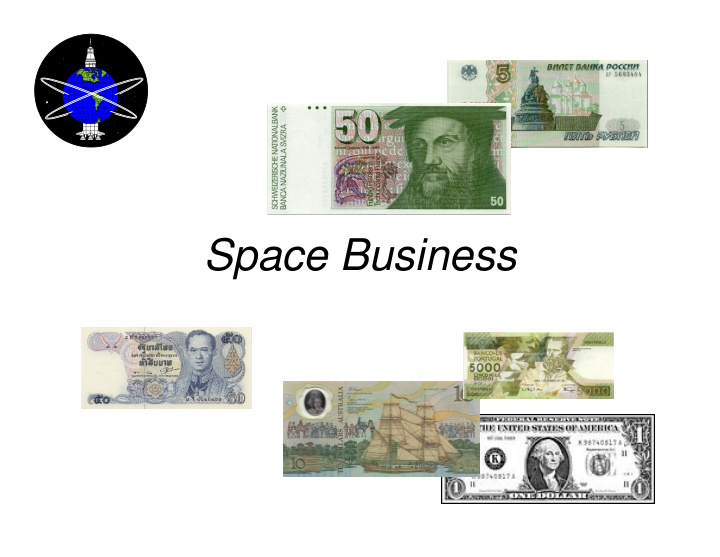



Space Business
Overview •Satellites • Telecommunications • Remote Sensing •Rockets •Space Tourism •Activity
Satellites Some companies use satellites to beam telephone conversations, television broadcasts, and data. Other companies use satellites to take pictures of the Earth, a process called remote sensing. In order to get their satellites in space, they hire companies that launch rockets.
The Electromagnetic Spectrum The electromagnetic spectrum is used by telecommunications satellites and remote sensing satellites. Typical telecommunications bands Microwave Radar Infrared Visible Ultraviolet X-ray Gamma Satellite remote sensing regions
Telecommunications Satellites Images courtesy of CubeSat (upper left) and Boeing
Telecommunications Satellites Satellites are like really, really tall communication towers. They also use things called transponders, which receive transmissions from the ground (CNN in Afghanistan), convert to a new frequency, and beam to another point on Earth (a TV station near you).
Geosynchronous Orbits (GEO) About 35,790 kilometers up Arthur C. Clark Line of site •You need three satellites in GEO to cover the whole Earth •Today, there are about 200 operating commercial GEO satellites, with around 60 government satellites
Low Earth Orbits (LEO) From about 68 kilometers to 1,000 miles Example systems: •Iridium •Globalstar •Teledesic •ORBCOMM Satellite Images courtesy of Orbital Sciences Corporation
The Electromagnetic Spectrum and Telecommunications These are the frequencies used for telecommunications Radio and television bands VLF LF MF HF VHF UHF SHF EHF L S C X Ku K Ka V W mm Communication frequencies “broadband” Optical – fiber optics
What’s a Footprint? Satellites transmit to a particular area via a “beam.” The beam hits an area of the Earth called a footprint. Images courtesy of Rutgers University
Remote Sensing Satellites Images courtesy of NASA (lower left) and Orbital Sciences Corporation
Remote Sensing Satellites Method of data collection – Passive Most common, instruments (called imagers or sensors) simply collect reflected or radiating wavelengths of light, typically in the infrared (IR) and visible spectrum. – Active Instruments (such as radar) beam energy to an area on Earth and measure the terrain based on signal return time or the degree of absorption.
Polar Orbits LEO type, but around Earth’s poles instead of around its equatorial latitudes Images courtesy of Rutgers University
Sun-Synchronous Orbits Polar orbit type, but moving around Earth against the Satellite planet’s rotation so that the satellite always takes pictures in sunlight. Images courtesy of Rutgers University
The Electromagnetic Spectrum and Remote Sensing These are the frequencies used for satellite remote sensing Radar Infrared Panchromatic – Multispectral or hyperspectral
Who Builds Satellites? • Alcatel • Astrium • Ball Aerospace • Boeing • Lockheed Martin • Orbital Sciences Corporation • Space Systems/Loral • Others
Who Operates Satellites? • Space Imaging (remote sensing) • DirecTV (television) • Iridium Satellite LLC (telephone and data) • Loral Skynet (telephone and data) • New Skies (telephone and data) • SES Global (telephone and data) – SES Americom and SES Astra • XM Satellite Radio (radio) • Others
Who Uses Satellites? Image courtesy of Motorola • You do! – Telephone – Television – Beepers – Internet Image courtesy of Nokia – Maps – Weather forecasts – Others?
So Who Puts the Satellites Up There?
Rockets Special companies get paid to launch satellites into space. For each pound sent into space, you have to pay between $10,000 and $30,000. To launch the Space Shuttle, which is not available for commercial use, it costs about $350 million. To launch other rockets, it costs between $500,000 for a small converted missile to about $165 million for a large rocket.
Launch Providers • Boeing Launch Services – Delta 2, Delta 3, Delta 4, Zenit 3SL • International Launch Services – Atlas 2, Atlas 3, Atlas 5, Proton • Arianespace – Ariane 4, Ariane 5 • Kosmotras – Dnepr (converted ICBM) • Eurockot – Rockot (converted ICBM) • Others
Commercial Rockets Image courtesy of Orbital Images Sciences courtesy of Corporation Arianespace Images courtesy of Lockheed Image Martin courtesy of Sea Launch
Example Commercial Rocket Payload fairing (payload inside) 2 nd stage 1 st stage Ariane 44L Solid boosters Image courtesy of Arianespace
Recommend
More recommend